Enhanced comment feature has been enabled for all readers including those not logged in. Click on the Discussion tab (top left) to add or reply to discussions.
Teat and Udder Scores
Udder and teat quality definitely influence the profitability of beef production. Poor quality or injuries and disease of udders are a leading cause of culling and thereby lower cow longevity and lifetime productivity. Although larger udders have been associated with higher milk production and calf weaning weight, excessively large, pendulous udders and large teats may present difficulty for a calf to nurse, and thereby calf growth and weaning weight may be affected negatively. In general, more tightly supported udders and smaller teats should be considered desirable; however, the extremes of these conditions likely become detrimental at some point.
Phenotype
Deliberate, annual evaluation of udder quality is an essential component of cow-calf production. The Beef Improvement Federation recommends scoring udder suspension and teat size annually on cows within 24 hours of the cow giving birth. These subjective numerical scores (see table below) can easily be assigned in the pasture. Scores should be assigned according to the worst quarter of the cow’s udder. To ensure consistency and facilitate comparison of records, preferably one person should evaluate all cows each year and across years. Written notes about abnormal shapes or characteristics other than udder suspension and teat size may be useful.
| Udder suspension | Teat size | |||
|---|---|---|---|---|
| 9 | Very tight | 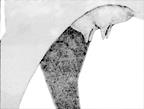
|
Very small | 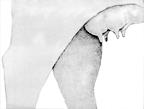
|
| 7 | Tight | 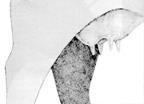
|
Small | 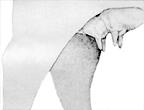
|
| 5 | Intermediate | 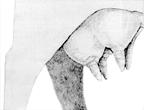
|
Intermediate | 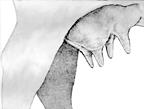
|
| 3 | Pendulous | 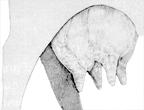
|
Large | 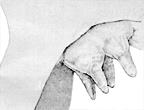
|
| 1 | Very pendulous | 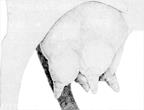
|
Very large, misshapen | 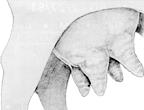
|
Images used courtesy of the American Hereford Association.
Genetic Evaluation
Udder characteristics are highly heritable and therefore can be efficiently changed with selection.[1] Substantial variation in udder dimensions can even be observed in herds that overall have good udders.[2] Shape of udder or teats can also influence calf performance.[3][4][5]
While highly correlated, udder and teat scores should be considered as separate traits and analyzed in a bivariate analysis. Using a simple repeatability model and including age of the cow as a fixed covariate should be sufficient, along with contemporary group of the calf at the time the score is taken. A simple linear model is sufficient for the analysis of the scored data. The EPD should be published on the score scale.
Usage
While not an economically relevant trait some organizations have emphasized the improvement of udder and teat structure in order to improve the perception of their cattle. These organizations have an implied breeding goal for the improvement of udder and teat structure. Developing enhanced culling codes will improve the understanding of how udder and teat defects impact culling, and thus, stayability EPDs.
References
- ↑ Bradford, H. L., D. W. Moser, J. Minick Bormann, and R. L. Weaber. 2015. Estimation of genetic parameters for udder traits in Hereford cattle. J. Anim. Sci. 93:2663–2668.
- ↑ Tolleson, M. W., C. A. Gill, A. D. Herring, P. K. Riggs, J. E. Sawyer, J. O. Sanders, and D. G. Riley. 2017. Association of udder traits with single nucleotide polymorphisms in crossbred Bos indicus-Bos taurus cows. J. Anim. Sci. 95:2399–2407.
- ↑ Kersey DeNise, R. S., D. E. Ray, A. M. Lane, V. L. Rundle, and M. Torabi. 1987. Relationships among udder shape, udder capacity, cow longevity and calf weights. J. Anim. Sci. 65:366–372.
- ↑ Frisch, J. E. 1982. The use of teat-size measurements or calf weaning weight as an aid to selection against teat defects in cattle. Anim. Prod. 32:127–133.
- ↑ Riley, D. G., J. O. Sanders, R. E. Knutson, and D. K. Lunt. 2001. Comparison of F1 Bos indicus × Hereford cows in central Texas: II. Udder, mouth, longevity, and lifetime productivity. J. Anim. Sci. 79:1439–1449.